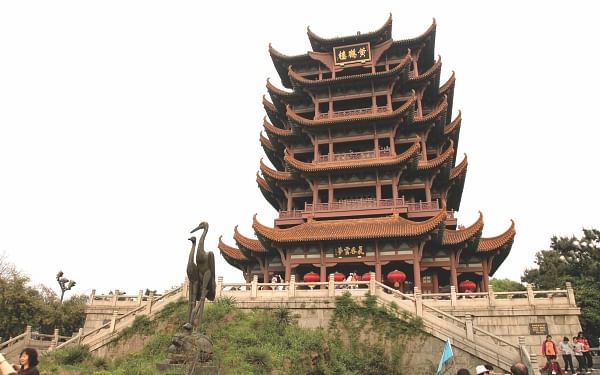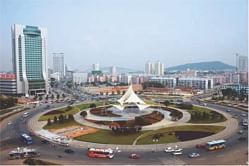| Home - Back Issues - The Team - Contact Us |
 |
| Volume 10 |Issue 43 | November 18, 2011 | |
|
|
Travel Wuhan, the Land of Chestnut and Yellow Crane Tower Dr Salehuddin Ahmed We visited Wuhan city and its two counties. In this article I will first talk about my personal experiences in the villages of the counties and then discuss about some of the enterprises we saw. The best part of this visit was an exposure to the villages, the villagers and their endeavours. From Beijing, Wuhan is about two and half hours by flight. From Wuhan we went to the counties of Luotian and Yingshan. The highway was beautiful, the scenery around was also spectacular. We crossed some tunnels through mountains (two lanes each way). As we reached the county we were checked into a hotel. The counties are like the district headquarters of Bangladesh, but much more developed, with excellent infrastructures. As we entered the county, we were welcome by the villagers with green tea and different kinds of nuts and crackers including boiled salted peanuts. In China, wherever we went, we were welcomed by green tea. As I was not used to green tea, it took me some time to acquire the taste of it, but now I enjoy green tea. I read that there are 20 different health benefits of taking green tea. We entered the villages, met people, talked to them and came to know many things, including their way of living. In a typical household, usually three generations live together. The houses are small, but mostly two storied, brick and mortar buildings, each having stores downstairs and bedrooms, two or three, upstairs. Some also have one bedroom downstairs. In China, it is interesting to observe that people, in general, like to interact with foreigners, especially the children. Thankfully, I have already learned a bit of Chinese and it is fun to talk to the people in my broken Chinese. We understand each other. Villagers become happy when they hear that I am from Bangladesh. Everyone knows Bangladesh, Sheikh Mujib and Dr Yunus.
We also saw some microfinance activities there. They told me that they had learned about microfinance from Bangladesh. I was so glad to know that they were following the Grameen Bank approach. They are also really interested in Bangladesh tigers. Tiger in Chinese is “lao hu”. So whenever I said I was from Bangladesh, people, including children, would say with a big smile, “Oh, you are from the land of Mengjiala (Bangladesh) lao hu !” When I talked to them, their parents became very happy. They ask their children to try some English with “shu shu”, meaning uncle. The most remarkable experience for me was having a dinner party with the villagers. There were about 15 of them, men and women in a very modest room. The villagers cooked in their own homes and brought the dishes, such as, rice, chicken, vegetables, noodles, potato fries, soup etc. It was not Chinese of our Dhaka Chinese restaurants, but original and genuine Chinese food in China. Food was really delicious. By this time, I had become used to eating with chopsticks. The villagers really enjoyed talking to me and asked me many questions about Bangladesh and my experiences in China. We also sang songs. I sang my most favourite, SD Burman's “banshi shune aar kaaj nai”. By this time, I had learned the famous Olympic song of 2008 in Chinese, “Wo he ni”, meaning 'I and you'. Most Chinese know this song. I sang that as well. People were amazed and highly appreciative. We had great fun. Let me now introduce the City of Wuhan. As the capital of Hubei Province, Wuhan has eight million residents and covers an area of 8,494 square km, with a water-area of around 2,500 square km. That is why it is also known as the Water City and the River City. Hubei province is located in the northern subtropical monsoon climate zone with an area of 1,859,000 square kilometers and a population of more than 60 million. 55 percent of Hubei is mountainous. Dating back some 3,500 years, Wuhan is an amalgamation of three smaller cities - Hankou, Hanyang and Wuchang - each separated from the other by a river. The three cities were united into Wuhan in 1927. We visited two of the most spectacular sites of Wuhan, the Number One Bridge and the Yellow Crane Tower.
The Yellow Crane Tower is the largest tourist attraction in Wuhan. The tower is a marvelous piece of architecture. It is said to have been originally built in 223 AD, giving it a history of over 1700 years. It has been destroyed in frequent disasters and rebuilt. The new Yellow Crane Tower was completed in June 1985, and listed as one of the National Best Forty Scenic Spots for Tourists. The view of the whole city of Wuhan is extraordinary from the top floor. One can walk around the top floor of the Tower and get the view of the whole of Wuhan city from all sides. The Number One Yangtze River Bridge is another beautiful site which can also be seen from the top floor of the Yellow Crane Tower. What a splendid view! This bridge was designed and partly built by the Russians and then completed by the Chinese about 50 years ago. It is more than a kilometer long with the first floor for trains and the upper for vehicles. From the bridge, one can view the famous Yangtze River as well as the mouth of the Han River, where it connects. We were taken to the villages under two counties, Luotian and Yingshan. It took us about two and a half hours to reach Luotian county by minibus. The four-lane highways were excellent. In the two counties, we visited townships and villages and saw the development activities there. Our stopovers at the Luotian County were: the Vocational School, the tea estate at the Dabieshan Mountain area, a chestnut farm in Fengyi'ao village, Hubei Huali Food Co., which processes chestnuts and exports to countries such as Japan. We also visited Meiyan, Fengyi'ao, Wuyunshan, Lijialou, Baizhanghe villages and the townships of Fengshan, Hongshan and Wenquan. We spoke with the people there about their initiatives and activities, especially their enterprises. We were really impressed to see a few of the people's enterprises. The Luotian County Secondary Vocational School is a specialized school of Technology, providing degree, diploma, continuing education and training programs for different skills, such as computer, tourism, automobile, and language. The degree program takes three years: two years of course work and one year interning with some relevant factories or enterprises. Students enter the school after high school graduation. They currently have about 4,000 students in different courses and 262 faculty members. The classrooms, labs, and dorms are quite impressive. Interestingly, most of the students are boys. Most of the graduates get jobs in different enterprises in cities of China. Secondly, the tea estate and its factory produce about 30,000 kg of tea. This is considered a medium-sized tea garden by Chinese standards. The most interesting part of this enterprise is that they have built up fairly good facilities for tourists to enjoy the sights and sounds of the tea gardens and the mountains surrounding the area. They say they are combining tea and tourism. There are more than 900 villages in the area, of which two-thirds are involved in tea production. This is the main income source for the villagers. They produce both black and green tea. They have been producing tea from 1956. The infrastructure was modernized in 1970 and the tourist facililties, hotels, restaurants, roads, etc. were renovated in 1999. They call it a “Tea Park”. Third, the Fengyi'ao Chestnut Farm was an experience for me, because I had never seen a Chestnut Farm. I spoke with the people in the farm about their product and operations. I learned so much. It is said that this area grows the best quality chestnuts in China. This farm is about 3 km away from Luotian county. The farm is cultivated by 15 village teams. The village has 1,850 people. Finally, the Hubei Huali Food Company processes the chestnuts, packages and then exports them. It is a fairly sophisticated, automated factory; nothing is touched by hand. I spent two nights in the field visit and stayed in two hotels in two townships. The standards of the hotels in the townships were quite good, including air-conditioned/heated rooms, restaurants, meeting rooms, nice lobbies etc. One even had lifts. In Wuhan I stayed in a very nice hotel with four-star facilities. It was another memorable trip for me.
Copyright
(R) thedailystar.net 2011 |
||

